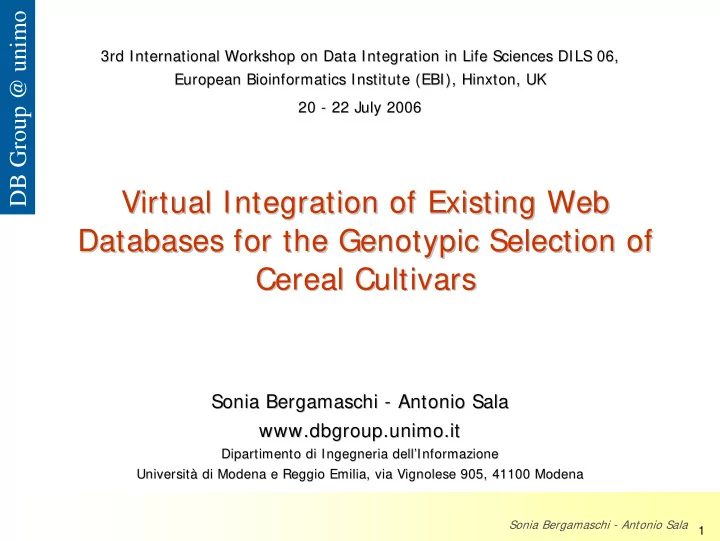

DB Group @ unimo 3rd International International Workshop on Data Workshop on Data Integration Integration in Life in Life Sciences Sciences DILS 06, DILS 06, 3rd European Bioinformatics Institute (EBI), European Bioinformatics Institute (EBI), Hinxton Hinxton, UK , UK 20 - - 22 22 July July 2006 2006 20 Virtual Integration of of Existing Existing Web Web Virtual Integration Databases for the the Genotypic Selection Genotypic Selection of of Databases for Cereal Cultivars Cereal Cultivars Sonia Bergamaschi Bergamaschi - - Antonio Sala Antonio Sala Sonia www.dbgroup.unimo.it www.dbgroup.unimo.it Dipartimento di Ingegneria dell’Informazione Dipartimento di Ingegneria dell’Informazione Università di Modena e Reggio Emilia, via Vignolese Università di Modena e Reggio Emilia, via Vignolese 905, 41100 Modena 905, 41100 Modena Sonia Bergamaschi - Antonio Sala 1
DB Group @ unimo Motivations Motivations • To perform intelligent data integration of existing databases to create a Global Virtual View (GVV) for the genotypic selection of cereal cultivars. • The GVV has been realized with the MOMIS system (Mediator envirOnment for Multiple Information Sources) developed by the Database Group of the University of Modena and Reggio Emilia as a part of the CEREALAB project conducted by the Agrarian faculty of the University of Modena and Reggio Emilia in collaboration and funded by the Regional Government of Emilia Romagna. Sonia Bergamaschi - Antonio Sala 2
DB Group @ unimo The MOMIS Integration Process Integration Process The MOMIS COMMON THESAURUS GVV GENERATI ON WRAPPI NG GENERATI ON (CEREALAB) ODLI 3 GLOBAL LOCAL SCHEMA 1 SCHEMA DERI VED CLASSES RELATI ONSHI PS CEREALAB LEXI CON DERI VED RELATI ONSHI P Structured S ODLI 3 source Export clusters LOCAL SCHEMA 2 OWL generation Common Gramene Thesaurus Structured USER SUPPLI ED source ODLI 3 RELATI ONSHI PS LOCAL SCHEMA 3 MAPPI NG TABLES I NFERRED Graingenes RELATI ONSHI P S Structured source AUTOMATI C/ SEMI -AUTOMATI C MANUAL ANNOTATI ON SYNSET # ANNOTATI ON SYNSET 4 SYNSET 1 SYNSET 2 Sonia Bergamaschi - Antonio Sala 3
DB Group @ unimo The ODL I3 Language The ODL I3 Language MOMIS uses an object-oriented language called ODL i3 as a common data model for integrating a given set of local information sources. ODL i3 extends ODL with the following relationships expressing intra- and inter-schema knowledge for the source schemata: • SYN (synonym of) • BT (broader terms) • NT (narrower terms) • RT (related terms) By means of ODL i3 , only one language is exploited to describe both the sources (the input of the synthesis process) and the GVV (the result of the process). ODL i3 is based on the OCDL description logics. Translators ODL i3 /OCDL and OCDL/ODL i3 are available. Sonia Bergamaschi - Antonio Sala 4
DB Group @ unimo Global Virtual View Generation Generation Global Virtual View MOMIS • Identifies and groups similar ODL i3 classes (classes that describe the same or semantically related concept in different sources) into clusters (global classes) • Generates mappings among global and local classes in the cluster Cluster generation: affinity coefficients are evaluated for all possible pairs of ODL i3 classes, based on the relationships in the Common Thesaurus properly strengthened – Affinity coefficients determine the degree of matching of two classes based on: – their names (Name Affinity coefficient) – their attributes (Structural Affinity coefficient) – Affinity coefficients are fused into Global Affinity coefficients calculated by means of the linear combination of the two coefficients – Global affinity coefficients are used by a hierarchical clustering algorithm, to include ODL i3 classes in clusters according to their degree of affinity • The designer may interactively refine and complete the proposed integration results Sonia Bergamaschi - Antonio Sala 5
DB Group @ unimo Mapping Refinement Mapping Refinement • A Mapping Table (MT) is automatically generated for each global class of a GVV. • The designer can extend the MT by adding: – Data Conversion Functions from local to global attributes – Join Conditions among pairs of local classes. – Resolution Functions for global attributes to solve data conflicts of local attribute values. • MOMIS provides some standard kinds of resolution functions for solving data conflicts for each global attribute mapping onto local attributes coming from more than one local source: • Random • Aggregation • Coalescence • Precedence function • All Values Sonia Bergamaschi - Antonio Sala 6
DB Group @ unimo The MOMIS Query Query Manager Manager The MOMIS The MOMIS Query Manager is the coordinated set of functions which allows the user to query the GVV Query processing consists of the following steps: • Query rewriting • to rewrite a global query as an equivalent set of queries expressed on the local sources (local queries) • Local queries execution • the local queries are sent and executed at local sources • Fusion and Reconciliation • The local answers are fused into the global answer Sonia Bergamaschi - Antonio Sala 7
Recommend
More recommend